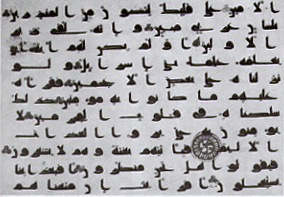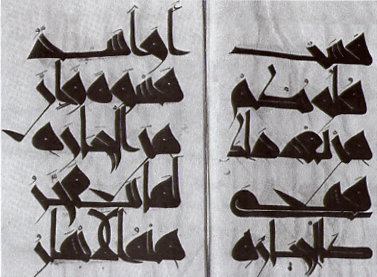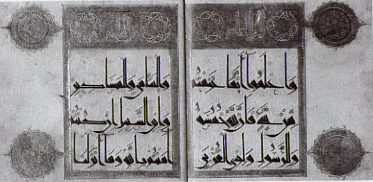
Kufic Quran, second/eighth century
by John F. Healey and G. Rex Smith
The Kufic Quran has reached its fully developed form by the end of the second/eighth century. It was invariably written on parchment, the letters in a black ink with dots, often red and green (the latter used with initial hamza) though sometimes in gold only, representing short vowels, and black strokes, single and double, distinguishing letters. The text thus written is made difficult by the spacing which would seem to be more to do the calligrapher’s artistic inclinations and his desire to justify his text precisely than with Arabic orthography. “Justification†here refers to what became the standard practice in printed books of making the lines even in length both at the beginning and at the end of the lines. Verse endings and other pauses call for gold: usually a cluster of three balls, one sitting on two others and quite elaborate roundels. Readers should note that the final mîm now has acquired a tiny tail and final nûn does not yet form the semi-circle which we see in the naskhî script. Frequently, marginal illuminations can be found in gold and chapter headings too are written in gold. The codices produced for such Kufic Qurans have a horizontal format, the top and bottom of each leaf being longer than the two sides, what in today’s computerized printing is called “landscape†as contrasted with “portrait.â€

Western Kufic Quran, fourth/tenth century
From about the late fourth/tenth century, one begins to detect a distinct western development, western Kufic, with its origins in North Africa and which was to herald an entirely distinctive Maghrebi script later. As if in reply at about the same time or a little later, we see and eastern Kufic, appearing in Iraq and Iran. Both continued to rely on the strong black ink to make the forms of the letters and – in the early stages at any rate – they used coloured dots with gold decorations. The eastern development in particular began to acquire a more familiar appearance, with black dots to distinguish letters and short vowels and other orthographic signs in a form readily recognizable today.

Eastern Kufic Quran, Late fourth/tenth century
The Kufic story is not quite told, for it is necessary to deal briefly with the script and its development used as a tool in inscriptions, be they lapidary – funerary or architectural – or numismatic. The difficulties of nomenclature have already been mentioned and the epigraphic role of Kufic can perhaps be reduced to three important types. By the fifth/eleventh century, foliated Kufic was much in evidence, so called because leaves formed the decoration of the apices of the letters. Floriated Kufic has much the same decoration with the addition of floral motifs growing from the terminations of the letters. The third type is plaited Kufic, in which the letter shapes are woven or plaited together to form an elaborate, pleasing and usually entirely symmetrical pattern.
Excerpt from John F. Healy and G. Rex Smith, A Brief Introduction to the Arabic Alphabet (London: Saqi Books, 2009), pp. 85-89.